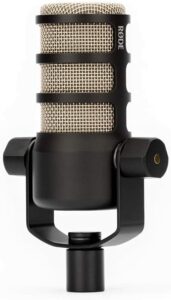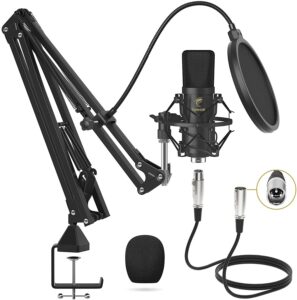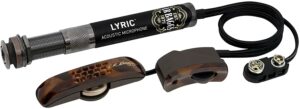Best Microphones
Best Dynamic Microphone

Best Condenser Microphone

Best Ribbon Microphone

Best Acoustic Guitar Microphone

But first – what are the different types of microphones?
Dynamic Microphones
Picture your favorite singer or comedian on stage, they are most likely holding what is known as a dynamic microphone. A dynamic microphone uses an inductive coil connected to a diaphragm and placed within the field of a permanent magnet. As the diaphragm moves, the coil moves as well which then varies the voltage that the coil produces. It is these subtle shifts in output voltage that in turn shape the mic’s output. Most of the dynamic microphones on the market have internal shock mounting and tend to perform well in live sound situations. They are relatively affordable and durable as well.
Ribbon Microphones
Ribbon microphones utilize the same core principles as other dynamic mics, but instead of using a diaphragm, they employ a thin ribbon that vibrates to vary voltage. These are often used in the studio for recording voices and a broad range of instruments. Ribbon microphones soften sound and impart warmth to recorded material.
Wireless Microphones
Wireless microphones are equipped with a transmitter to allow for a greater range of movement. A battery-powered transmitter sends the mic’s signal to a receiver that is connected to a mixer or PA system. The microphone utilizes radio frequencies to transmit the signal, with the most common types being digital, UHF or VHF frequencies. The best kinds of these systems use digital technology that optimizes audio quality while also eliminating noise and signal dropouts. Interference from unwanted sources like radios, cell phones, and fluorescent light fixtures are also detected and eliminated through these more advanced systems. Wireless microphones come in a variety of types including hand-held models, clip-on lavalier mics, and head worn mics that are equipped with a headband.
Condenser Microphones
Condenser microphones utilize a thin conductive diaphragm that is located within close proximity to a backplate, creating a capacitor. This capacitor has a small electric charge that comes either from phantom power or from a battery. The pressure of the sound waves will cause the diaphragm to vibrate, changing the distance between it and the backplate, causing variations in the output voltage. These microphones use an external power supply, internal batteries, or phantom power which is supplied by the mixer input. Most of these microphones are used for recording. Some are used for live sound such as overhead mixing of choirs, pianos, string instruments, and certain percussion instruments like cymbals for example.
USB Microphones
There is no doubt that computer-based recording has revolutionized the way that music and voices are recorded in this day and age. If you are routing your music through your computer’s sound card, there are many options available to you including the more sophisticated digital audio workstations and digital mixing boards, and the more simpler interfaces that simply offer connections for a single mic or instrument. USB-powered mics are the most simple of all, as they offer plug-and-play convenience with their sound recording ability. They are a great choice for those who need a quick and convenient solution to record their sound.
Best Dynamic Microphone

Looking for a high quality microphone for under $100? Look no further than the Rode PodMic Cardioid Dynamic Podcasting Microphone, which currently retails on Amazon for $99. You are sure to enjoy this microphone just as much as its other satisfied customers as the microphone boasts a 4.8-star rating across 1,500+ reviews.
The Rode PodMic has a broadcast-quality dynamic capsule and is optimized for speech applications. It features a robust, all-metal construction, and is sure to deliver exceptional sound quality, no matter what purpose you use it for.
This specific model is great for podcasting, featuring a rich, balanced sound with an internal pop filter. The purpose of an internal pop filter is to minimize plosives and internal shock mounting to reduce vibration. It has a dynamic acoustic principle, cardioid polar pattern, XLR Output connection, and does not require phantom power.
Complete your setup with the RODECaster Pro Podcast Studio, for which the Podmic is optimized for use. Or, you can create your own high-quality microphone interface as this microphone is sure to offer exceptional results no matter what additional accessories you choose.
Best Condenser Microphone

If you remember from earlier in the article, condenser microphones are utilized most often in studios for recording artists. Other use cases include home studio recording, podcasting, voice-over work, streaming on websites like Twitch, YouTube video production and many more! If you are looking for an affordable microphone to add to your recording equipment, consider the XLR Condenser Microphone. Currently retailing for just under $50 on Amazon, this setup kit features a 4.6 star rating across 1,750 reviews.
This kit contains almost everything you need to get started producing your signature sounds. The upgraded mic capsule features a low-noise FET preamplifier, high SPL handling, and a wide dynamic range that provides smooth, high-end clarity. The TC20 adopts a cardioid polar pattern with excellent off-axis sound suppression capabilities. These sound suppression capabilities expertly reduce the sound pickup from the side and rear and better eliminate background noise, to ensure an overall great sound production experience.
The package includes a condenser microphone, metal shock mount, a mic cover, pop filter, boom arm, desk clamp, cable ties, an an XLR male to XLR female cable. Be aware that an external power source is required for this set up – you will need to connect the TC20 to 48V phantom power, audio interface, mixer, or preamp.
Setup is easy when you follow the instructions in the included manual. This microphone features a cardioid polar pattern, and a 16mm capsule size. Your microphone is sure to help you produce a clear, warm, natural sound.
Best Ribbon Microphone

Ribbon microphones utilize the same core principles as other dynamic mics, but instead of using a diaphragm, they employ a thin ribbon that vibrates to vary voltage. These are often used in the studio for recording voices and a broad range of instruments. Ribbon microphones soften sound and impart warmth to recorded material.
If you are looking for a great ribbon microphone to add to your setup, you should consider the Royer R-10. This microphone currently retails for $499 on Amazon and has a 5 star rating across 18 reviews. The R-10 utilizes a patented 3-layer protective wind screen system and an internally shock mounted transducer.
The maker of this microphone, Royer Labs, is dedicated to the art of the ribbon microphone. They began creating the modern ribbon microphones in 1998 and has since received the Technically Grammy Award for bringing ribbon microphones into mainstream recording around the world. Microphones are the first and most influential part of the recording chain, which is why it is so important to invest in a quality piece of equipment. Royer ribbon microphones like the R-10 help you to capture the most natural sounding recordings possible.
Every Royer is hand-made in the USA by master craftsmen who are meticulous about building the best ribbon microphones in the world.
Best Acoustic Guitar Microphone

Using a microphone to capture the sound of an acoustic guitar? Next time you have a live performance, utilize the L.R. Baggs Lyric Acoustic Guitar Microphone for your recording needs. This microphone currently retails for just under $200 on Amazon and features a 4.2 star rating across 92 reviews.
The Lyric microphone is the next step in Tru Mic technology. This microphone will accurately transport your guitar’s voice to a live audience for the most realistic and inspiring sound that you can imagine. This featherweight microphone is high graded for ideal response and easily mounts to the underside of the bridge plate with a peel and stick adhesive. This ensures that the microphone will preserve the integrity of your instrument.
The Lyric microphone leverages the “pressure zone” principal by positioning the capsule just 3mm from the surface of the top to hear the entire soundboard for even balance and tone. Better yet, the mic’s proximity to the top allows high gain before feedback as well. Lyric also employs noise cancelling technology that rejects “boxy” reflections inside of the acoustic chamber. This allows the mic to act as if it were outside of the guitar delivering a clear and open performance.
To put this microphone’s capabilities into perspective, in a studio you would have to use an entire rack of gear to achieve what is built into the circuit board of the Lyric microphone. There are several “black box” innovations that are included with this microphone including tightening the lower frequencies, maintaining the mic’s sweetness, and an adjustable “presence” control that dials high frequency response perfectly.
The Lyric microphone is a world class microphone system that will become an integral part of your guitar anywhere you plug in.
FAQs about microphones
What are polar patterns?
You should decide whether you want the microphone to only record what is directly in front of you, or if it should pick up the sound from all around you. Although the polar patterns can sound and look complicated, it is important to remember the only question you’re looking to answer is “What do I want the microphone to record?”
The cardioid is a popular polar pattern, picking up sound in a heart shape around the top of the microphone. The omnidirectional polar pattern mics pick up sound in all directions.
What is sensitivity and SPL?
Sensitivity is simply a measurement of the quietest sound the microphone will still be able to pick up. The lower that number is, the more sensitive the microphone is, and the quieter the sound can be that will end up in the final recording. SPL stands for sound pressure level, and is a decibel measurement of the loudest sound.
What is frequency response?
The frequency response of something refers to how well the components of the microphone can actually reproduce the signals it is picking up. The way frequency response is measured is through a frequency response graph. If a certain note of a signal comes out of the mic slightly weaker than it went in, this is visualized as a slight dip in the graph. If ti comes out more powerful than it went in, it is visualized as a slight hump.
Can audio cables run alongside other electronic wires or appliances?
When wires run close to one another, their resistance can face some negative consequences. If you run wires perpendicular to one another instead of parallel, you may be able to bypass consequences they have on resistance.
Are balanced or unbalanced cables better?
If you have balanced equipment you should always use balanced cables for synchronicity. For unbalanced cables, the most important feature to take into account is length. Keep your cables under six feet long to prevent interference.
Are shorter wires really better?
It’s all about finding a happy medium. You want your cable to be long enough to easily connect to and reach your instruments but you want it to be short enough to keep the resistance low.

